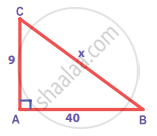Advertisements
Advertisements
प्रश्न
In the given figure, ABC is a triangle in which ∠ABC < 90° and AD ⊥ BC. Prove that AC2 = AB2 + BC2 − 2BC.BD.

उत्तर
Applying Pythagoras theorem in ΔADB, we obtain
AD2 + DB2 = AB2
⇒ AD2 = AB2 − DB2 … (1)
Applying Pythagoras theorem in ΔADC, we obtain
AD2 + DC2 = AC2
AB2 − BD2 + DC2 = AC2 [Using equation (1)]
AB2 − BD2 + (BC − BD)2 = AC2
AC2 = AB2 − BD2 + BC2 + BD2 −2BC × BD
= AB2 + BC2 − 2BC × BD
APPEARS IN
संबंधित प्रश्न
In the given figure, ∠DFE = 90°, FG ⊥ ED, If GD = 8, FG = 12, find (1) EG (2) FD and (3) EF

Digonals of parallelogram WXYZ intersect at point O. If OY =5, find WY.
Find the Pythagorean triplet from among the following set of numbers.
4, 7, 8
A ladder 15m long reaches a window which is 9m above the ground on one side of a street. Keeping its foot at the same point, the ladder is turned to other side of the street to reach a window 12m high. Find the width of the street.
Find the unknown side in the following triangles
The top of a broken tree touches the ground at a distance of 12 m from its base. If the tree is broken at a height of 5 m from the ground then the actual height of the tree is ______.
In a right-angled triangle ABC, if angle B = 90°, BC = 3 cm and AC = 5 cm, then the length of side AB is ______.
In a right-angled triangle ABC, if angle B = 90°, then which of the following is true?
Two squares are congruent, if they have same ______.
In a triangle, sum of squares of two sides is equal to the square of the third side.
